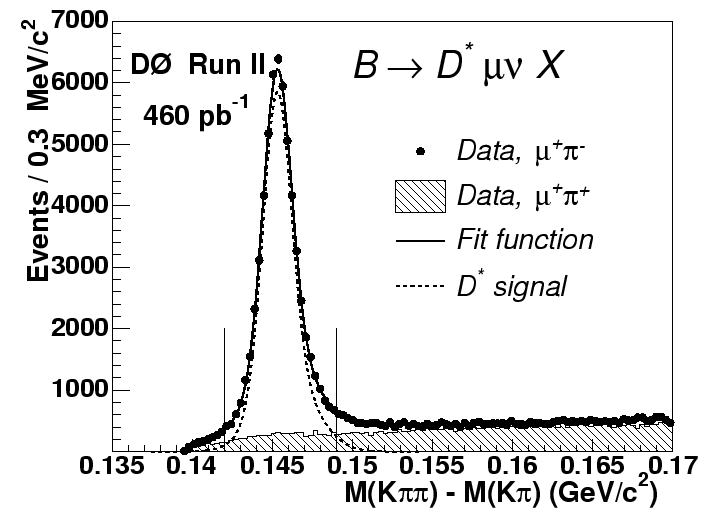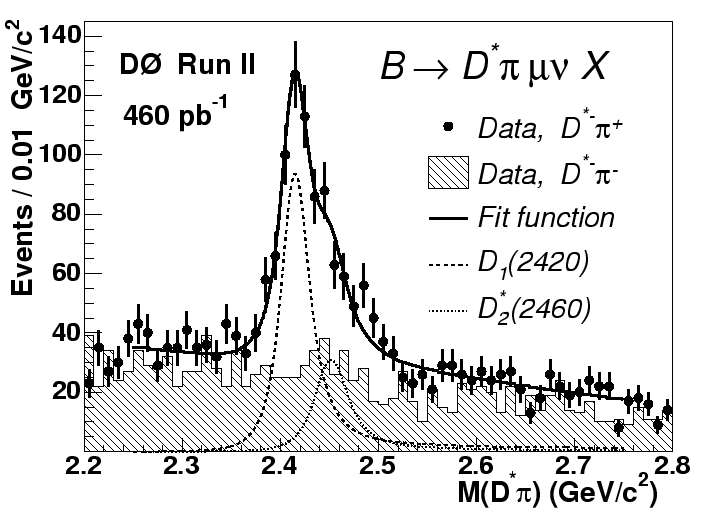Plain English
Summary of
"Measurement of
semileptonic branching fractions of B mesons to narrow D** states"
B mesons, which are bound states of the b-quark and a lighter quark,
play a special role in the elementary particle physics due to their
heaviness and long lifetime. The B mesons were subject of extensive
studies during recent years with thousands of papers published
throughout the world. In this study we investigated properties of B
mesons decaying to the excited D mesons (also known as D**) accompanied
by a charged and neutral leptons : a muon and neutrino. This
paper explores a universal theoretical description of B meson decays:
Heavy Quark Effective
Theory (HQET),
which exploits the heaviness of the B meson . We measured a parameter
predicted by the theory : the
ratio of probabilities to decay to one of two possible narrow states.
Physicists at Fermilab have a long history of studying B mesons at the
Tevatron collider. These mesons are abundantly produced in the
proton-antiproton
collisions and experiments use complicated trigger algorithms and
electronics
to select those events out of billions of other collisions. At the
analysis
phase B mesons are reconstructed combining a muon and several
other
charged particles. Muons are very similar in properties to electrons
but they
are
about 200 times heavier. Experimentalists like muons because they
do
not interact much with matter and reach the outmost part of the
detector
penetrating through thick slabs of iron. This allows for easy
identification
of the muons. The other particles in the same event have to form at
least one
excited D meson.
The D mesons are composed of a "charm" quark and a light ("up" or
"down") anti-quark. Similarly to the hydrogen atom the quarks inside
the D meson can have
relative orbital momentum or to be "excited". Following the same
analogy the "excitement" is removed by a decay to a state with lower
potential energy (or in this case to a state with lower mass) emitting
an extra particle (typicaly a charged or neutral pion) . As always in
quantum mechanics the orbital momentum is
quantized and also obeys selection rules, which allow only certain
decays. In our study we concentrate on allowed chain decays of the type
shown
below:

The D mesons
can be reconstructed as peaks in the invariant mass distributions as
shown
in the figures below. To select the D*+ meson we look
at the mass difference between the kaon-pion mass and kaon-pion-pion
mass, see the plot below.

Four species of the D** mesons different in quantum numbers are
predicted by the theory and two out of four are expected to be
"narrow". The term "narrow" in this case applies to the width of their
invariant mass distribution (~10 MeV/c^2) and means that they appear as
clearly visible resonances in the
invariant mass of products of their decay : D* and pion, see the
plot below. The peak in the plot can be interpreted as two merged
narrow resonances, which are also shown separately in the same plot.
The obtained statistics is 10 times larger than seen previously in
other experiments and this allowed us to accurately measure the rates
of how often the B mesons decay to those two D** resonances and compare
them to each other.

This result was submitted for publication in Phys.Rev.Letters in July
2005.
The full text of the submitted publication can be found at the link
below.
http://arxiv.org/abs/hep-ex/0507046
Please address your further inquires to the primary authors:
Gennadi Borissov, Sergey
Burdin, Andrei Nomerotski.


